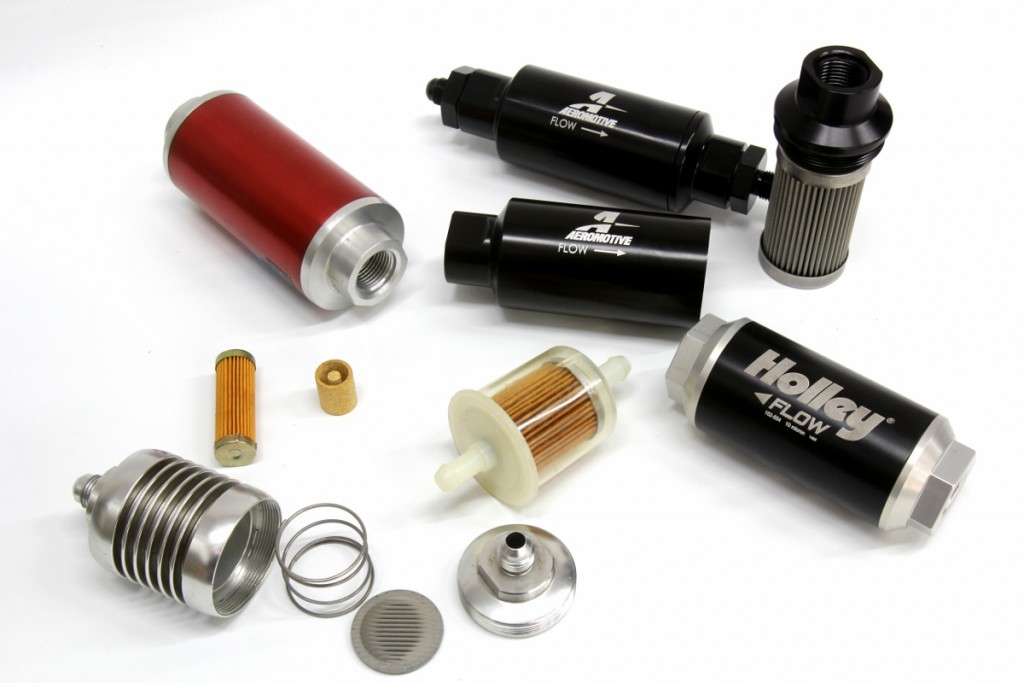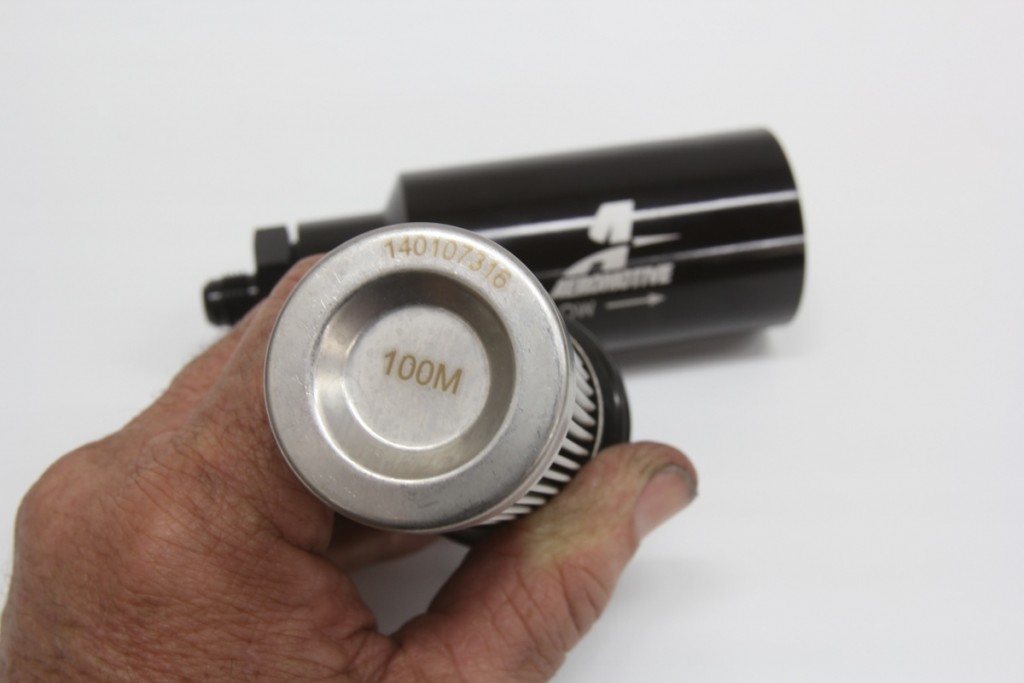How Do You Clean An Aeromotive 100 Micron Stainless Steel Fuel Filter

In that location are lots of options when it comes to fuel filters, but in that location are only a few smart choices for any engine making over 500 hp. Regarding filers, bigger is always improve.
Photos and Words past Jeff Smith
In Shakespeare's Richard III, in the middle of the battle, he cries "A horse, a horse! My kingdom for a equus caballus!"
The 21st Century equivalent of that cry is a chip more muddled because when horsepower dies today, it might be more than difficult to figure out where it went! Nosotros recently visited a store where they had only removed a thumpin' 572c.i. Chevrolet Operation big-block from a customer'southward car because he had given up trying to make the engine run right. The solution was to swap in a late model LS engine.
Function of the conversion called for an upgrade from the original carbureted fuel delivery organisation to 1 designed for high-pressure level and EFI. While removing the original fuel line, the guys discovered the existent reason why the 620 hp Rat motor never ran correct. The rear-mounted electrical fuel pump was more than big enough to feed the engine, only was plumbed using a fuel filter with an area the size of a quarter. The filter was plugged with all kinds of debris and was obviously incapable of flowing anywhere near the amount of fuel the engine required. The engine didn't burn a piston considering the filter restricted menstruation so severely, it couldn't make enough power to hurt itself!
This may audio like a simple oversight — which it apparently is. But, this is non an isolated instance. Making big ability in the 21st Century has never been easier. Mag stories today don't consider a 500-hp engine to be anything special. Attention seems to have focused now on street engines making upwards of 1,000 hp. What is oft overlooked is the volume of fuel it requires to make this kind of horsepower. Withal, information technology seems many enthusiasts accept non made the mental transition when it comes to filters. While almost everyone's attending is focused on high chapters fuel pumps, there's more than a petty thought and consideration that must exist paid to the filter as well.
Permit's showtime with the more demanding EFI fuel delivery arrangement. The best way to build a high-pressure EFI fuel delivery system is by designing it as a return arrangement. This starts with a pre-filter alee of the pump, forth with another filter after the pump with a finer filter and the unabridged organisation plumbed with sufficient size lines and full-menstruation fittings. The render line must also be the same size as the feed line to preclude backpressure. Nosotros will focus this story on filters, simply an emphasis on the entire organization as a whole is the only way to create a successful and efficient fuel delivery construction.
The most disquisitional location or position in whatsoever fuel delivery arrangement is the inlet side of the pump. All pumps, including electrical fuel pumps, will deliver maximum functioning when the inlet to the pump is unrestricted. This is because pumps are designed to push fuel and are generally not efficient at pulling fuel into the inlet. This is why submerged, in-tank pumps are past far the most efficient. Nonetheless, an inlet filter is still required because loftier pressure EFI pumps operate using very tight tolerances. If debris finds its style into the pump, the result is likely a quick failure.
We will exist using Aeromotive'southward recommendations for filters, and these same requirements will agree true with any high-output fuel commitment system. The idea is to create a residue between protecting the pump while minimizing menses restrictions. Aeromotive specifies a 100-micron filter for the inlet side of an EFI pump. A micron is equal to 0.00039-inch, which means a 100 micron filter is capable of trapping debris that's at to the lowest degree 0.039-inch in diameter and perhaps slightly smaller. This will prevent large strange material from harming the pump. Every bit the filter's micron rating number becomes smaller (trapping finer particles) it also becomes more of a restriction. A 100 micron rating on the inlet side still filters big particles but is a minimal brake. On the high pressure side of the pump, the spec is far tighter to remove material that could foul a fuel injector. The Aeromotive spec for this filter recommends ten microns (0.0039-inch), a full ten times finer than the inlet side.
But, even more of import than the particle size is the filter's surface area. Common sense dictates that a large expanse for a filter is probably more important than its screen size. A large surface area allows the filter to practise its job for an extended period of time without worry that debris will reduce fuel catamenia. That's why these filters are and so big. Keep in mind that during office-throttle functioning, nearly all of the fuel is returned to the tank. This moves the fuel through these filters far more oftentimes than a not-render organisation.
There'south also a option of filter materials. Aeromotive and others offer both paper (cellulose) or a cleanable stainless steel. Manifestly, the stainless media allows the user to clean the filter and re-utilize it — assuming, of course, your cleaning solution (like muddy solvent) does not add debris to the filter!
I of import bespeak is to never use a cellulose or paper filter with E85 fuel. Aeromotive says they have seen issues where ethanol creates a gel when used with a paper fuel filter. Retrieve, ethanol is predominantly an organically-based fuel, as opposed to pure gasoline that is petroleum-based. E85 is no different that grain alcohol except for the 15-percent gasoline mixed with information technology. Then, to prevent this "biological fouling" — essentially a bacterial slime — from growing inside your fuel organisation, stick with stainless steel filters. To support this, Aeromotive makes a special twoscore-micron stainless steel filter peculiarly designed for use with E85.
Carbureted systems are no less vulnerable, as evidenced by the architect's misuse of that tiny fuel filter on that 572c.i. big-block example in our story introduction. It's like shooting fish in a barrel to understand how this oversight could happen. While carbureted fuel pressures are significantly lower than EFI systems, fuel volume is nevertheless a crucial requirement. The engine's horsepower potential determines the flow capacity required of the system. You can't make horsepower without fuel.
A simple equation can help in determining capacity. Nosotros'll go along the math to a minimum, merely if a normally-aspirated big-cake Chevy is capable of 750 hp, let'south assume a BSFC number of 0.five. BSFC is the acronym for brake specific fuel consumption — a fractional rating of the pounds of fuel required to make ane horsepower for one 60 minutes. In this case, that comes to a one-half-pound of fuel per horsepower per hour. If the number were larger (0.65 for example), the engine would require more than fuel to brand the same horsepower. Conversely, if the BSFC number is smaller (0.35 as an instance), it is more efficient at converting fuel into power, requiring less fuel.
So with a BSFC of 0.5, this means for a 750-hp engine, we divide 750 by 0.50, which gives us a minimum of 375 pounds of fuel per 60 minutes. In lodge to ensure nosotros will supply plenty fuel, nosotros volition add a little "head room" to the number, making it 400 pounds of fuel per 60 minutes equally a safety margin. Divide 400 pounds past the weight of gasoline at 6.2 pounds per gallon and that equals virtually 65 gallons of fuel per hr at a minimum force per unit area of at least 5 to vi psi.
Despite the fact carburetors don't demand the same pressure as EFI systems, flow is still important. With menstruum rates increasing with college horsepower engines, a full return-way organization is the best way to build a system, even for a carburetor. This tin be easily achieved with a return-style regulator.

If you lot're not sure of the cartridge's filter rating, information technology is stamped on the airtight end of the filter. In this instance, it's a 100 micron filter.
Regarding filters for a carbureted application, a 100-micron inlet filter is still a good thought while the force per unit area side filter does non take to exist quite then fine, so a 40 micron filter with a large area would be the all-time. Because of these lower pressures, these inline filters can be slightly smaller with no fear of menstruum restrictions. For instance, the Aeromotive PN 12335 filter offers a slightly shorter five.5-inch long torso with a stainless steel twoscore-micron filtering ability that can hands accommodate fifty-fifty a dual-carbureted Pro Stock big-cake application.
As street cars become more sophisticated and engines go along to make more power, the fuel filter is one of those few instances where bigger is improve and where more surface area only means more menstruum. So at least here, yous can't go wrong by going big.
Sources: Aeromotive; 913/647-7300; aeromotiveinc.com; Holley Performance Products; 270/781-9741; holley.com; Edelbrock(Russell); 310/781-2222; edelbrock.com
How Do You Clean An Aeromotive 100 Micron Stainless Steel Fuel Filter,
Source: https://www.streetmusclemag.com/tech-stories/filtering-the-facts-how-to-avoid-major-fuel-filter-mistakes/
Posted by: stewartasher1959.blogspot.com


0 Response to "How Do You Clean An Aeromotive 100 Micron Stainless Steel Fuel Filter"
Post a Comment